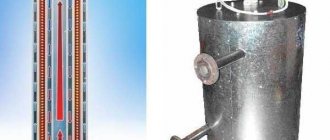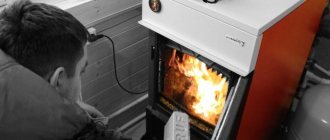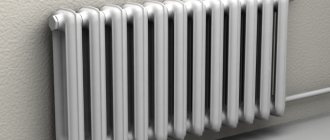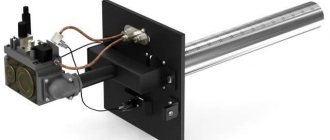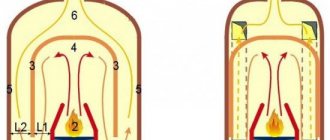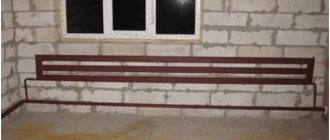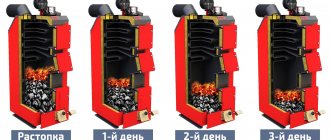Any waste, which for an ordinary person is just garbage that needs to be disposed of, in the hands of a master can bring tangible material benefits.
For example, scraps of pipes of different sizes, an old gas cylinder and other metal scraps will be turned into a furnace, and waste oil will be turned into fuel. Organizing heating using waste oil with your own hands is not so difficult.
We will tell you about the main options for installing heating systems using waste fuel. The article we have proposed describes in detail how to manufacture home-made devices that have been tested in practice. Taking into account our recommendations, you can achieve optimal results.
Device
Any boiler operating in mining is designed as follows: the burner creates a torch that heats the firebox (combustion chamber), surrounded on all sides by a water jacket. The hot gases give off heat to the water jacket, then pass through smoke pipes, also surrounded on all sides by water.
This boiler design is called two-pass or reversible, because the gases pass through the firebox in one direction, then return through the smoke pipes and go into the chimney. There are three-pass boilers that have an additional row of smoke pipes, which causes the smoke to make another turn and move to the far end of the firebox, from where it goes into the chimney.
Since waste often contains all kinds of debris and antifreeze, a filter is installed in front of the burner to clean the fuel and reduce the risk of nozzle clogging.
In addition, the firebox must have at least one cleaning door through which the slag formed as a result of oil combustion is removed and the walls of the combustion chamber are cleaned of soot.
This is especially true when the heating device is operating in low power mode, because the release of thermal energy, and therefore the heating of the walls of the firebox, is minimal, which is why not all the fuel entering it burns . Some of the fuel is only partially oxidized and soot settles on the walls of the combustion chamber.
If you do not clean the boiler of soot for a long time, then as the power increases, the temperature in the combustion chamber will increase and the soot may ignite, which will sharply heat up the walls of the furnace and lead to a jump in the temperature of the coolant until it boils.
In addition, any boiler must have means for adjusting power and controlling the torch; without this, the danger of using a heating device during testing increases tenfold.
General operating principle
If we want to get high-quality heating based on waste, we cannot simply take the oil and set it on fire, as it will smoke and stink. To avoid these unpleasant and hazardous side effects, you need to heat the fuel so that it begins to evaporate.
Volatile substances obtained as a result of heating will burn. This is the basic principle of operation of the heating unit during testing.
Image gallery
Photo from
Heating device made from improvised means
Homemade model with turbocharging
Connecting the module to a conventional stove
Miniature coffee stove
Application of perforated tube
To implement this principle, the design of the stove includes two chambers, which are connected to each other by a pipe with holes. Fuel enters the lower chamber through the filler hole, which is heated here. The resulting volatile substances rise up the pipe, becoming saturated with air oxygen through the perforation.
A schematic diagram of a two-chamber stove with a connecting perforated pipe allows you to understand exactly how a simple unit functions during mining
The resulting combustible mixture ignites in the chimney, and its complete combustion occurs in the upper afterburning chamber, separated from the chimney by a special partition. If the process technology is properly followed, virtually no soot or smoke is generated during combustion. But the heat will be enough to warm the room.
Using the plasma bowl
In order to achieve maximum efficiency of the process, you can go a more complicated route. Let us recall that our goal is to separate volatile components from the fuel by heating it. To do this, a metal bowl should be placed in the only chamber of the unit, which must not only be heated, but heated.
Through a special dispenser, waste will flow from the fuel tank into the chamber in a thin stream or drops. Once on the surface of the bowl, the liquid will instantly evaporate, and the resulting gas will burn.
The efficiency of this model is higher, since fuel supplied by drip burns better, and the problem of topping it up during the operation of the furnace disappears by itself
If everything is done correctly, the combustion of gases should be accompanied by a bluish-white flame. A similar flame can be observed when a plasma burns, which is why the red-hot bowl is often called a plasma bowl. And the technology itself is called drip feed: after all, fuel must be supplied in exclusively small doses.
With all the variety of designs, the operation of all heating units using waste fuel is based on the principle described above.
How to determine the sufficient power of a heating device?
The power of the boiler should be several percent greater than the heat loss of the building , so the smaller it is and the better it is insulated, the less powerful the apparatus is needed to heat it.
It is generally accepted that in central Russia, for a well-insulated house, the boiler power should be 1 kW for every 10 m2 of its area.
That is, to heat a building with a total area of 155 m2, you will need a heating device capable of constantly delivering 16 kW of thermal energy .
However, to reduce the load on the heating device and increase the reliability of the entire system, we recommend increasing the power by 15–25%, that is, for a house with an area of 155 m2, a boiler with a capacity of 18–20 kW/h would be ideal.
Ignition of the oil furnace
Unfortunately, the design does not have automatic ignition using piezo or electricity. The manipulations are complex and require experience:
- The condition of the unit is checked every time it is necessary to put it into operation. If necessary, the chimney and other channels are cleaned.
- Attention should be paid to the fuel tank to ensure that no water has entered it. What this entails is written above. In addition, it is important that there is a sufficient supply of fuel in the tank each time - 2-3 liters.
- Light the stove using a wick. They make it themselves, and the whole process is reminiscent of lighting a kerosene lamp. The oven does not set immediately, within 5 minutes. When stable combustion is ensured, the draft and other parameters for a productive process should be adjusted.
You can regulate the heat supply using devices on the unit itself. For this purpose there are dampers, valves, etc.
Where can I get the drawings?
Finding drawings of a boiler and burner for a certain power is not easy, because few people develop heating devices that operate only on waste oil; much more often they make a universal boiler with given power parameters and a burner for it.
Therefore, to search for drawings, calculations and recommendations you have to re-read various forums , including those on solid fuel heating devices, because the boiler itself works equally well with any heat source.
Often, such DIYers take some old gas or even wood-burning boiler, restore it to working condition, and then make a burner for it with certain torch parameters.
One of the most important elements of such a boiler is a controller that checks the presence of a torch and also regulates the fuel supply depending on the temperature in the house.
Therefore, we have prepared links to forums where users discuss the independent production of all parts of such heating devices.
These are the links:
- www.forumhouse.ru.
- termoportal.ru.
- fermer.ru.
- www.land-cruiser.ru.
- forum.abok.ru.
- www.rusfishing.ru.
- forums.drom.ru.
- www.chipmaker.ru.
- www.allremont.ru.
- forum.yourdom.ru.
- boatclub.ru.
- krainamaystriv.com.
- mwob.com.ua.
Making a pallet for mining
The tray was made from a cast iron automobile brake disc. Cast iron has good heat resistance, so I decided to use it.
I will make a pallet from this disk
I welded the bottom underneath.
The steel circle is the bottom. Welded the bottom
I welded the lid on top. In it you can see the counterpart of the burner and the opening. Air enters the stove through the opening. I made it wide - it's better that way. With a narrow opening, the air draft may not be strong enough, which is why the oil will not be able to get into the pan.
Next I made a coupling. In my stove it connects the pan and the burner. With a coupling it will be much easier to maintain the stove. If necessary, I can take out the tray and clean the burner from below.
Next I made a couplingCouplingPutting the coupling in placePutting the coupling in place
The coupling was made from a 10-centimeter pipe, simply cutting it along the longitudinal edge. I did not weld the opening in the coupling - there is no need for this.
How does the burner work?
There are 2 types of burners:
- evaporators (drip);
- injectors (supercharged).
The basis of the drip burner is the evaporator bowl into which fuel slowly drips.
Part of the waste burns in the bowl, increasing the temperature there and starting the pyrolysis process, while the other part evaporates and breaks up into volatile hydrocarbons and other gases, which rise above the bowl, mix with the incoming air and burn.
The fuel supply system monitors the amount of fuel in the bowl and either opens the valve to replenish the amount of liquid, or closes it to prevent waste from overflowing.
The main advantages of the evaporator are:
- simplicity of design;
- the ability to function in training of any quality.
The injector works differently. First, the fuel is heated to make it more fluid, then it is fed under pressure through a calibrated hole into the mixer, into which air is pumped. In the mixer, waste and air are mixed, after which they exit the nozzle into the combustion zone.
The mixture can be ignited using an open fire, an electric arc or a hot metal plate. They regulate the power of the injector by changing the volume of air supply and oil pressure , so that the ratio of fuel to fuel will always be the same.
If you do not have experience in making such devices, then make an evaporator, because it is easier not only to assemble, but also to configure, but it is almost twice as efficient.
Fire safety measures
It should be understood that such a home-made structure must be made strictly in accordance with established fire safety standards.
To protect the premises from fire, we also recommend adhering to the following rules:
- The chimney diameter must be at least 100 mm. Ideally, use sandwich pipes, on the surface of which a minimum amount of soot is formed.
- It is prohibited to store flammable items (fuel tanks) in the immediate vicinity of the tanks.
- All joints must be sealed.
- The thickness of the walls of the tanks where fuel combustion occurs must be at least 4 mm.
- To ensure the flow of fresh air into the room and to avoid smoke, it is necessary to equip the boiler room with a forced circulation system. The air exchange rate per 1 cubic meter of area is 180 m3/hour.
General rules and warnings
The thermal inertia of heating boilers is noticeably higher than that of metal stoves (potbelly stoves or heaters), but much lower than that of brick stoves, and power adjustment by reducing the fuel supply is associated with the emission of carbon dioxide and carbon dioxide.
Therefore, for comfortable safe operation of such devices, the following conditions must be met::
- Install the boiler in a room located outside the house or in a separate room with good ventilation.
- Regardless of the burner type, be sure to use any devices to monitor CO and CO2 levels.
- Use combustion control devices that will notify you if the torch goes out for some reason.
- Remove all flammable materials from the boiler room, including curtains or wooden floors, if there is a spill of burning waste, but on a concrete floor it will quickly go out, and the only consequence will be heavy smoke in the room.
- If it is possible to use heating devices using any other type of fuel, including electricity, use them, because a boiler in production, especially a homemade one, is a backup device whose task is to help you hold out until the main heat generator is connected.
- When switching to exhaust from another source, be sure to adjust the burner. If you can’t do this normally, change the configuration of the device or make another device optimized specifically for this fuel.
- Store used oil in non-flammable sealed containers.
- Before each start, check the traction.
- Monitor the coolant level in the boiler.
Flaws
Despite the obvious advantages of this type of coolant, there are still a number of disadvantages:
- The need for filtration before injecting into the system. The fact is that usually the oil is a mixture of many oils of different brands and viscosity. In addition, it contains third-party components in the form of dirt and metal. The process of cleaning a considerable volume can cost a large sum.
- Availability of the required quantity. At the moment, there are no companies that are engaged in the targeted collection and purification of oil for future infusion into heating systems. Therefore, finding a sufficient amount of the desired consistency will be problematic.
- High fire hazard. In the event of a leak, there is a risk of fire. True, for this the liquid must come into direct contact with an open source of fire.
- It is not permissible to use a boiler with direct heating.
- Replacing all rubber gaskets and connectors with oil-resistant ones, which will be more difficult to find, since conventional heating systems are not equipped with them. In addition, their purchase can cost a large sum.
Scope of use
The first such units were developed in order to dispose of waste oil products (they were called that way: recyclers). They were designed so that the percentage of harmful emissions was minimal. A little later they figured out how to use the generated heat for heating, after which many modifications of the devices appeared.
Visual operating principle of the burner Source gwsigeps.com
Modern heat generators are varied in design; They are designed for heating the following premises:
- Car service centers, technical centers, hangars.
- Locksmith workshops, industrial premises, warehouses.
- Other industrial premises, private houses and summer cottages.
Any natural or synthetic waste oil, or a mixture of several oils, is suitable for use. The fuel can be oil:
- waste: motor, hydraulic, transmission, transformer (from machine tools and any equipment);
- drained from cars, hydraulic equipment, diesel locomotives;
- drained from a cooking unit (for example, a deep fryer);
- vegetable oils: rapeseed, soybean, corn, sunflower (waste);
- diesel fuel, kerosene.
- fuel oil, heating oil.
Waste oil heating for a private home
Waste heating oil was initially used together with diesel fuel. This method has proven its effectiveness and cost-effectiveness. Then they decided to reduce the cost of the product even more and removed diesel fuel from the composition. Used oil resembles diesel fuel in its characteristics, but is much cheaper.
Photo 1. This is what used oil looks like, which is used for heating. The liquid is dark brown in color.
Features of use
The waste is used as fuel in a special boiler or furnace. Only this guarantees complete combustion of the product without the formation of fumes. Re-equipment of the heating system or installation of a new circuit pays for itself in the first year of use of the product.
Types of fuel. How much heat is produced by burning one liter?
Burning one liter of such fuel produces 10-11 kW of heat per 60 minutes. The pre-treated product has more power. Its combustion produces 25% more heat.
Types of used oils:
- motor oils and lubricants used in various types of transport;
- industrial products.
Advantages and disadvantages
Pros of fuel:
- Economic benefit. Consumers save money on fuel, but businesses benefit the most. The implementation of processing eliminates the costs of storage, transportation and disposal of the product.
- Conservation of energy resources. Refusal to use gas and electricity for heating prevents the depletion of sources.
- Environment protection. Due to the high cost of disposal, business and vehicle owners disposed of oil by dumping it into waterways or into the ground. This had a negative impact on the environment. With the beginning of the use of waste as fuel, such manipulations stopped.
Disadvantages of fuel:
- poses a health hazard if the product does not burn completely;
- large dimensions of the chimney - 5 m in length;
- difficulty of ignition;
- the plasma bowl and chimney quickly become clogged;
- The operation of the boiler leads to the combustion of oxygen and evaporation of moisture from the air.
How is oil processed?
Processing is obtained by burning any type of oil, but for heating the premises, oil refining products from internal combustion engines are usually used.
Also from industrial mechanisms, compressors and power equipment.
What does not apply to such fuel?
List of products not related to waste:
- processed oils of vegetable and animal origin, which are used for household needs;
- solid waste with processing;
- solvents;
- products that are not subject to the same processing as waste;
- natural petroleum fuel from the spill;
- other unused petroleum products.
How to make a waste oil boiler with your own hands
The simplicity of the design of such heating devices allows you to make them yourself. In this case, it is necessary to have metalworking and welding skills.
Tools and materials
To make a boiler with your own hands, you need the following equipment:
- Bulgarian;
- welding machine;
- hammer.
To make a waste oil boiler with your own hands, don’t forget the grinder
As a material for the heating structure, you must purchase:
- fire-resistant asbestos sheet;
- heat-resistant sealant;
- steel sheet 4 mm thick;
- metal pipe with a cross section of 20 and 50 centimeters;
- compressor;
- ventilation pipe;
- sweeps;
- bolts;
- steel adapters;
- half-inch corners;
- tees;
- reinforcement with a cross section of 8 millimeters;
- pump;
- expansion tank.
The boiler body for heating small rooms can be made of pipe; for a device with a higher power it is best to use steel sheets.
Manufacturing process
The waste oil unit can be built in any shape. To heat a garage or small agricultural buildings, it is best to make a small boiler from pipes.
The manufacture of such a heating device consists of the following steps:
- A metal pipe with a large cross-section is cut so that its size corresponds to one meter. Two circles corresponding to a diameter of 50 centimeters are prepared from steel.
- The second pipe with a smaller diameter is shortened to 20 centimeters.
- A hole corresponding to the size of the chimney is cut out in the prepared round plate, which will serve as a cover.
- In the second metal circle, intended for the bottom of the structure, an opening is made, to which the end of a pipe of smaller diameter is connected by welding.
- We cut out a cover for a pipe with a cross-section of 20 centimeters. All prepared circles are welded as intended.
- Legs are constructed from reinforcement and attached to the bottom of the housing.
- Small holes are drilled in the pipe for ventilation. A small container is installed below.
- An opening for the door is cut out in the lower part of the body using a grinder.
- The chimney is attached to the top of the structure.
To operate such a simple boiler during mining, you just need to pour oil into the tank from below and set it on fire with a wick. Before this, the new structure should be checked for tightness and integrity of all seams.
Construction of a more powerful boiler
Two boxes are made from durable steel sheets, which are connected using a perforated pipe. In the design it is used as an air outlet.
The subsequent manufacturing process of the heating device has some features:
- A hole is made in the lower body of the boiler to supply oil to the evaporation tank. A damper is attached opposite this container.
- The box located in the upper part is complemented by a special hole for the chimney pipe.
- The design is equipped with an air compressor, an oil supply pump and a container into which fuel is poured.
DIY waste oil boiler
If water heating is required, an additional circuit is connected, which requires the installation of a burner. You can build it yourself:
- half-inch corners are connected by bends and tees;
- a fitting is attached to the oil line using adapters;
- all connections are pre-treated with sealant;
- a burner cover is cut out of sheet steel to match the sockets on the manufactured boiler;
- two different sized steel plates are used to install the burner;
- the inside of the tube adapter is tightly covered with an asbestos sheet, which is secured with sealant and secured with wire;
- the burner is inserted into the housing intended for it;
- after this, a smaller plate is fixed in the socket and covered with four layers of asbestos;
- a large plate is mounted as a mounting plate;
- holes are drilled in it for fastenings, and an asbestos sheet is applied on top;
- two prepared plates are connected using bolts.
To prevent the burner from falling apart while the boiler is operating, all parts should be carefully and tightly secured. The device is ignited by a glow plug.
Waste oil boilers are considered economical and practical devices. You can purchase them at a specialty store or build them yourself. When using such heating devices, you must remember the safety rules, which include the mandatory installation of a chimney, the presence of a ventilation system and proper storage of liquid fuel.
Results
Thus, do-it-yourself oil heating is a fairly economical system, and at the same time, worthy of replacing other heating systems. Such systems are also used for autonomous heating. However, the specificity of this option lies precisely in the fuel used, so this alternative is considered as an extreme case: when there are no other options or there is a lot of used oil. The main area of application for such devices is industrial enterprises, where among the waste there is a large amount of used oil.
Principle of operation
In essence, a traditional solid fuel boiler works like a regular stove. There is also a firebox in which wood (coal, pellets and other types of solid fuel) burns. The released energy heats the coolant located in a container above the combustion chamber.
The coolant in this design is heated both from the internal pancake and from the chimney, which penetrates through the container with water. At the same time, the boiler body also heats up, which creates an accumulating effect that inhibits rapid cooling when the unit is turned off.
The heated coolant rises up and exits through the upper pipe into the supply circuit of the heating system. The cooled coolant enters the boiler through the lower pipe connected to the return circuit.
